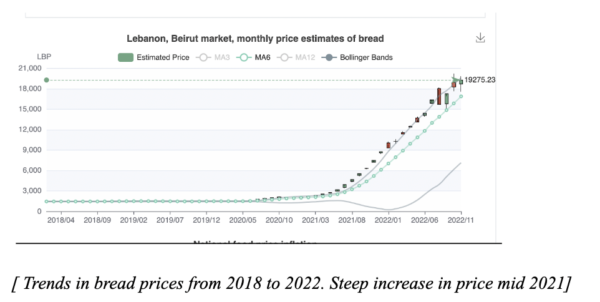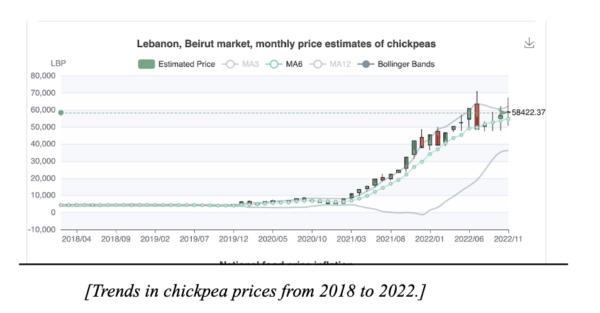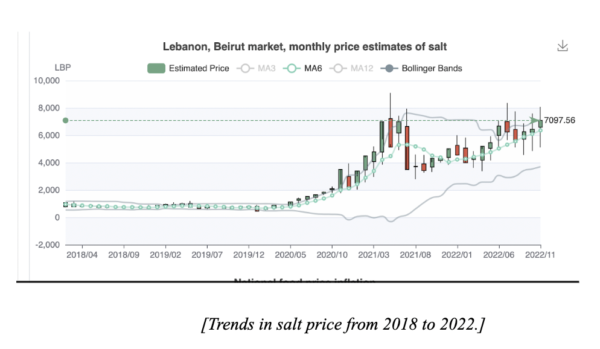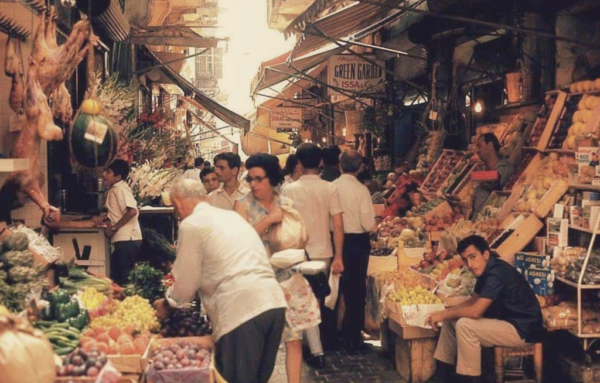An Overview
This article will explore the context and impacts of food insecurity across Lebanon. Lebanon’s economic crisis is complex. Political instability obscures questions of accountability and who shapes future policy. Emerging black markets for cash and goods alike complicate an understanding of the economic lives of Lebanon’s residents. NGOs and international aid organizations are implementing a range of interventions. Recognizing the multiple dimensions and layers of the crisis, this article will seek to contextualize raising food prices, not as a singular issue, but as one that reflects the broader economic and political backdrop defining the nation.
Macroeconomic Downturn in Lebanon
Lebanon’s economic crisis has been long in the making, rooted in the nation’s elite political class blowing out the budget to rebuild the nation after the civil war in 1990. Rebuilding and investment efforts were financed by taking on foreign debt instead of using sources of domestically produced income. To pay creditors back, further debt was taken on, creating a vicious chain of irresponsible spending with no plan to pay it back. This financial plan is comparable to swiping your credit card on luxury purchases, knowing very well that your bank account is nearly empty.
The Arab Spring shook the region’s political landscape in 2011. Furthermore, it became increasingly apparent that the ruling political class lacked the commitment to deliver on their promises for meaningful widespread reform. Investors’ uneasiness about the region’s political future and aid agencies’ distaste for the corrupt elite eventually halted cash flow into the nation. Value of the Lebanese Lira plunged and Lebanon failed to repay its debts.
Today, 82% of the Lebanese population lives in poverty.
We hope that the given context on Lebanon’s macroeconomy will frame your understanding of current trends in prices and cost of living. But certainly, conversations about the Lebanese economy can have extensive boundaries. So why do we care specifically about food prices? A few reasons.
- Historically in the Middle East, food insecurity has been a reliable precursor to widespread political protest. Many experts claim that inflated food prices was one of the major factors that ignited the Arab Spring. This makes sense logically. When individuals feel insecure about their ability to feed their families and anxious about the source of their next meal, they have a strong reason to turn out in the streets and demand reform. Thus, food prices say something meaningful about political attitudes on the ground and a nation’s political future.
- Rising food prices alter lifestyles. Patterns of consumption change; consumers may opt for lower-quality substitute goods or cut out non-essential or luxury items. So, food prices say something interesting about how people are changing their everyday behaviors and decision-making. It indicates that people may be living less fulfilling lives and that their way of thinking about food, often a major part of culture, is changing.
The Current Food Crisis: Prices and Daily Life
In 2019, 36% of households spent over 50% of their incomes on food expenditures. In comparison, the average household in the U.S. spent only 10.3% of their household income on food expenditures. Percent of income spent on food is an important metric to consider when assessing economic security. A high percentage point of income spent on food spells trouble. First, it means that a majority of one’s income is going towards basic human sustenance, leaving little room for spending on shelter, transport, or even modest luxury. That diminishes the quality of life. Second, when a high percentage of income is spent on food, even a small change in income will affect food consumption. In a nation like Lebanon, with high unemployment and value of currency constantly changing, this concern is certainly pronounced.
The graphs below show fluctuations in staple food items such as chickpeas, bread, and salt in the capital city of Beirut. These items were chosen because they represent the basic consumption set of a typical Lebanese consumer. So, increases in the prices of these staple items certainly mean that consumers will be shelling out more at the cashier. Steep increases in costs as well as unpredictably of future prices have contributed to unprecedented levels of food insecurity.



With prices of staple items soaring, products like meat, once an integral part of daily diets, are being treated as luxuries. Estimates suggest that meat consumption rates are drastically plummeting, at rates between 65-82%. Specifically, as the price of red meat increases disproportionately to white meat, consumers are substituting red meat for poultry products or opting for exclusively plant-based diets. Even the Lebanese army has cut its provisions of meat to soldiers on duty, citing “difficult economic conditions.”
A Trickle-Down Effect: From Global and National Markets to Individual Consumer
Lebanon depends heavily on global markets to source food—everything from wheat to processed items. Little is produced within Lebanon’s borders, despite potential for agricultural prosperity. While domestically centered production does not entirely protect a market from the shocks of global economic and political events, the Lebanese economy is uniquely exposed to the impacts of global instability due to its increased reliance.

With the devaluation of the Lebanese Lira (currency), it has become more expensive to buy goods on the global markets. Recent estimates suggest that the value of the Lebanese Lira against the US dollar has seen a 90% decrease. Geopolitics also plays a role. Lebanon depends on Ukraine for 80% of its supply of wheat, an unequivocally staple ingredient. So, the Russian invasion of Ukraine has slowed the process of cultivating and exporting grain. Wheat has become scarce and thus more expensive.
Cost of production and business operations have also soared. Petrol prices are up by 25% and daily power cuts limit business operations. With prices of gas cylinders—also an import—up, households and businesses are forced to switch to wood stoves, the more affordable yet less efficient alternative. Businesses are forced to raise prices if they want to remain profitable in spite of increased operation costs and reduced efficiency.
The Agriculture Industry: Barriers to Domestic Production of Food
Lebanon’s agriculture industry has long been on the back burner. Historically, Lebanon has invested little capital and cash into the industry, built few dams necessary for freshwater collection, and has had heightened emphasis on other sectors such as banking. As a consequence, Lebanon’s agricultural industry has suffered neglect. In spite of Lebanon’s abundant arable land and available fresh water, only 60% of viable land is cultivated annually. With markets for key agricultural inputs such as seed and fertilizers being dominated by a few large companies, mirroring an “oligopolistic structure,” quality of products is lowered while prices remain high. With fewer and more complacent players in the market, the incentive to create better and more cost-efficient products are diminished.
Interventions: Policy and Grassroots
While the state system remains weak, aid organizations, both local and global, have launched efforts to increase food access throughout the country. However, it is important to note the strings attached to global aid. For example, the IMF will withhold further aid to Lebanon (and any other nation in fiscal crisis for that matter) until they can commit to significant fiscal reform and discipline. For Lebanon, showing such commitment still remains difficult given the lack of a strong government with a clear vision for the future and commitment to its people.
Alternatively, NGO-based initiatives such as efforts to teach youth the skills necessary to grow vegetables in their backyards or implementing local farmers’ markets that cut out costs charged by middlemen are making good-faith efforts to alleviate the crisis and build resilience in communities.
In Conclusion
The economic crisis is multifaceted, with food prices being simply a subset of broader economic questions the nation must navigate. However, honing in on food prices provides an insight into how these macroeconomic questions are relevant to everyday people. We hope this resource compels you to seek out more information on the crisis in order to better understand its nuances and explore pathways forward.
Afterthought — Discussion Questions to Consider:
- How can foreign aid be structured and designed to reach the Lebanese population directly, circumventing the corrupt hands of politicians?
- Where is Lebanon currently in the process of political reform? What stands in the way?
- How might shifts in food consumption patterns affect cultural or religious practice?


